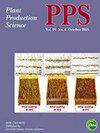Genetic analysis of root vascular traits in a population from two temperate japonica rice ecotypes
IF 1.3
3区 农林科学
Q2 AGRONOMY
引用次数: 1
Abstract
ABSTRACT The genetic basis for root vascular traits in rice, despite its direct impacts on root axial and radial hydraulic conductivity, has not been widely studied compared with deep rooting traits. We used five phenotyping datasets (i.e. from maturity stage grown in upland field in 2013, and from vegetative and maturity stages grown in upland and lowland fields in 2019) to quantify the genotypic variations and genomic regions of root vascular traits in a temperate japonica mapping population (from lowland Otomemochi (OTM) and upland Yumenohatamochi (YHM)). YHM had larger stele transversal area (STA) and total late metaxylem area (LMXA), as well as higher deep root ratio and total root length at deeper layers (>30 cm) than OTM. Root vascular traits were significantly different among progenies in each dataset, and the size of genotype-by-environment interactions was comparable. Root vascular traits were not positively correlated with deep rooting traits. From the multi-environment analysis of all five datasets, four key genomic regions related to STA in both joint and separate analyses were detected on chromosome 2 (RM3703-RM6379, RM6933-RM3857), chromosome 4 (RM1388-RM5503) and chromosome 12 (RM247-RM155), with the first and third collocated with deep rooting traits. QTL-by-environment interaction was comparable to the main additive effect. This study is the first report on genomic regions of root vascular traits in a japonica mapping population. GRAPHICAL ABSTRACT两个温带粳稻生态型群体根维管性状的遗传分析
水稻根系维管性状的遗传基础虽然直接影响根系轴向和径向导水率,但与深根性状相比,尚未得到广泛研究。利用5个表型数据集(即2013年旱地生长成熟期和2019年旱地和低地生长营养期和成熟期),量化了温带粳稻作图群体(来自低地Otomemochi (OTM)和旱地yumenhatamochi (YHM))根维管性状的基因型变异和基因组区域。与OTM相比,YHM具有更大的柱截面积(STA)和总晚叶质部面积(LMXA),深层根比和总根长(bbb30 cm)更高。根维管性状在每个数据集中的后代之间存在显著差异,基因型-环境相互作用的大小具有可比性。根维管性状与深根性状无显著正相关。从所有5个数据集的多环境分析中,在2号染色体(RM3703-RM6379, RM6933-RM3857)、4号染色体(RM1388-RM5503)和12号染色体(RM247-RM155)上检测到4个与STA相关的关键基因组区域,其中1号和3号染色体与深根性状相关。qtl -环境相互作用与主加性效应相当。本研究首次报道了粳稻定位群体根维管性状的基因组区域。图形抽象
本文章由计算机程序翻译,如有差异,请以英文原文为准。
求助全文
约1分钟内获得全文
求助全文
来源期刊

Plant Production Science
农林科学-农艺学
CiteScore
5.10
自引率
4.00%
发文量
27
审稿时长
>36 weeks
期刊介绍:
Plant Production Science publishes original research reports on field crops and resource plants, their production and related subjects, covering a wide range of sciences; physiology, biotechnology, morphology, ecology, cropping system, production technology and post harvest management. Studies on plant production with special attention to resource management and the environment are also welcome. Field surveys on cropping or farming system are also accepted. Articles with a background in other research areas such as soil science, meteorology, biometry, product process and plant protection will be accepted as long as they are significantly related to plant production.
 求助内容:
求助内容: 应助结果提醒方式:
应助结果提醒方式:


